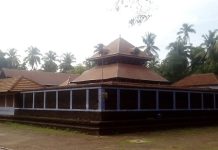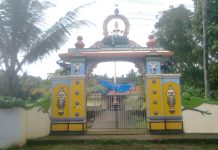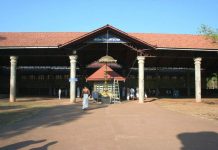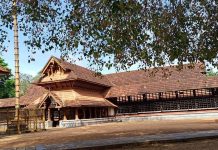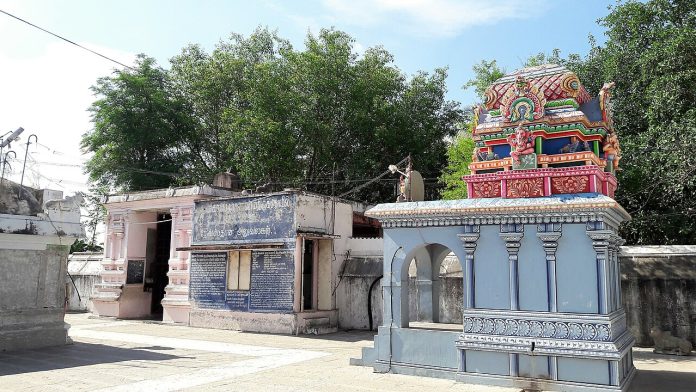
The Chandiranaar Temple, also known as the Kailasanathar Temple or Thingalur Temple, is a Hindu temple located in the village of Thingalur in Tamil Nadu, India. The temple is dedicated to Soma, the moon God, but the primary idol in the temple is that of Kailasanathar, also known as Lord Shiva. The temple is also called as Thingalur temple or Chandran Moon – Thingaloor Temple or Chandra Sthalam Thingalur (Kailasanthar) Temple. The temple is one of the nine Navagraha temples in Tamil Nadu and is an important destination on the Navagraha pilgrimage in the state. The original structure was built by the Cholas, but the present masonry structure dates back to the Nayak era in the 16th century.
According to Hindu belief, worshipping the Navagrahas, which include the sun, moon, and other planets, is essential to lead a good life. The grahas can have a positive or negative impact on an individual’s life, depending on their planetary position. The moon or Chandra is a significant deity in Hinduism, and the Chandiranaar Temple is one of the most revered Navagraha sthalams for moon worship in Tamil Nadu.
The moon is believed to influence an individual’s imaginative and intuitive nature, and a strong moon in the horoscope is considered auspicious. However, a weak or debilitated moon may lead to an unstable mind and financial instability. Visiting the Chandiranaar Temple is believed to be an excellent solution for those suffering from Chandra Dosha and can provide relief from unhappiness while offering emotional and mental stability.
Apart from being a Navagraha temple, the Chandiranaar Temple is also a Shiva sthalam, with the main idol being Kailasanathar accompanied by the goddess Periyanakiamman. The temple is famous for Annaprasana, where rice is first fed to infant children. The village of Thingalur finds mention in the 7th century Tamil Saiva canonical work, the Tevaram, written by Tamil saint poets known as the Nayanars. The temple is currently maintained and administered by the Hindu Religious and Charitable Endowments Department of the Government of Tamil Nadu.
Legends
Several legends are associated with the temple. According to one, during the Tamil month of Purattasi (Sep-Oct) and Panguni (March-April), moonlight falls directly on the temple’s presiding deity. Another legend tells of Chandra, the moon god, who angered his 28 wives by showing preference for the youngest. They complained to their father, Dakkan, who cursed Chandra to lose all his powers. Chandra is said to have worshiped at the Kailasanathar temple, and Lord Shiva restored his powers.
Another legend relates to the Hindu story of the churning of the cosmic ocean, during which Vishnu, in the form of Mohini, distributed Amrutha (nectar) among the devas. One asura, disguised as a deva, tried to consume the nectar and was beheaded by Vishnu’s Chakra. However, the asura had already consumed some nectar, so he could not be killed. His head became Rahu, and his body became Kethu. To escape Rahu’s wrath, Chandra prayed to Lord Shiva at the Kailasanathar temple and was blessed.
Finally, a devout merchant named Appoodi Adikal, who was a nayanar and devotee of Lord Shiva, is said to have hosted Thirunavukkarasar and sent his son to fetch a plantain leaf for the feast. The son was bitten by a snake and died, but Appoodi Adikal did not want to disappoint his guest. Thirunavukkarasar revived the child at the temple with a Thirupadigam, a devotional song, and the temple became associated with this miracle.
The Thingalur Kailasanathar temple is also considered astrologically significant, particularly for those born under the Gemini and Virgo signs. It is associated with the planet Mercury and is believed to have a positive influence on people’s lives.
History and architecture
The temple complex is believed to have been built by the Chola kings during the 10th and 12th centuries, with a masonry structure added during the Nayak period in the 16th century. The temple has a 5-tier rajagopuram and is surrounded by two prakarams. It has a unique feature of moon rays falling on the Shiva Lingam during certain months. The Shodasa Linga (16-sided Shiva lingam) at the main shrine is made out of black granite, which is a unique feature. The temple also has a separate shrine for the planet Moon, called as Thingal in Tamil. The village is briefly mentioned in the 7th century Tamil Saiva canonical work called the Tevaram, written by the Nayanars, a group of Tamil saint poets. The village is classified as a Vaippu Sthalam. The temple is maintained and administered by the Hindu Religious and Charitable Endowments Department of the Government of Tamil Nadu.
Festivals
The temple celebrates several festivals throughout the year, including Mahashivarathri in the Tamil month of Masi (February-March), Margazhi Tiruvadhirai in December-January, Panguni Uthiram in March-April, and Tirutarthikai in November-December.
The priests belonging to the Shaivaite community, a Brahmin sub-caste, perform the rituals and pooja both during festivals and daily. The temple rituals are performed six times a day, starting with Ushathkalam at 5:30 a.m. and ending with Ardha Jamam at 10:00 p.m. Each ritual involves four steps: abhisheka (sacred bath), alangaram (decoration), neivethanam (food offering), and deepa aradanai (waving of lamps) for Surya, Usha, and Chhaya. The worship is accompanied by music played on the nagaswaram (pipe instrument) and tavil (percussion instrument), religious instructions read by priests from the Vedas, and prostration by devotees in front of the temple mast.
The temple hosts weekly rituals like somavaram and sukravaram, fortnightly rituals like pradosham, and monthly festivals like amavasai (new moon day), kiruthigai, pournami (full moon day), and sathurthi. Mahasivarathri, Margazhi Thiruvadirai, Panguni Uthiram, and Thirukartigai are the major festivals celebrated in the temple. The temple is famous for the first feeding of rice to infant children.
Temple Timings :
The temple is open from 6:00 AM to 1:00 PM in the morning and from 4:00 PM to 8:30 PM in the evening.
How to reach
By Air: The nearest airport to Thingalur Temple is Tiruchirapalli International Airport, which is about 80 km away. From there, you can hire a taxi or take a bus to reach the temple.
By Train: The nearest railway station is Kumbakonam Railway Station, which is about 8 km away from Thingalur. From the railway station, you can hire a taxi or take a bus to reach the temple.
By Bus: Regular buses are available from Kumbakonam and other major cities in Tamil Nadu to Thingalur village. From the bus stop, you can take a short auto-rickshaw ride to reach the temple.
By Car: Thingalur is well connected to other cities in Tamil Nadu by roads. You can drive to the temple by car or hire a taxi from Kumbakonam or any nearby city.


























